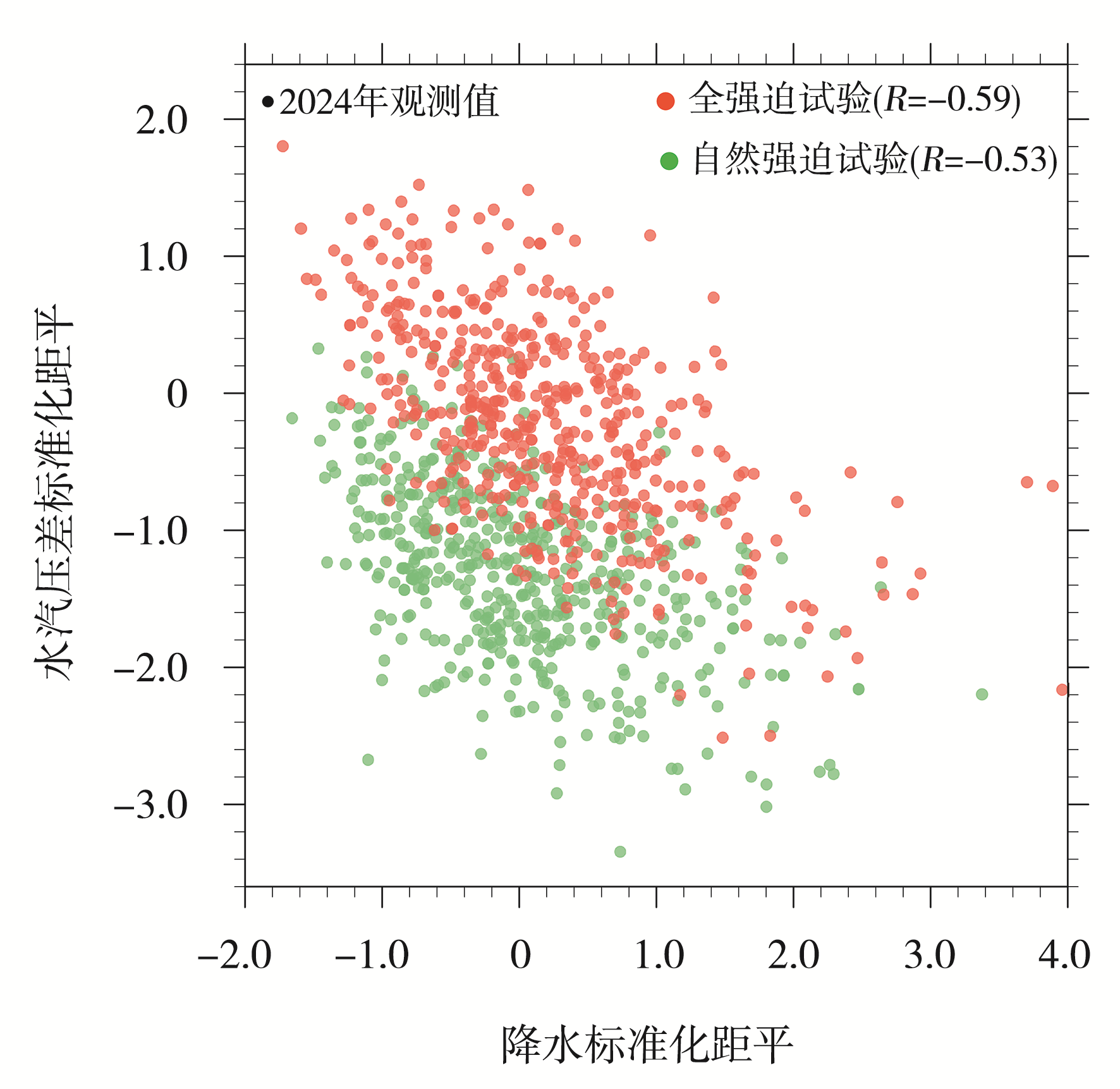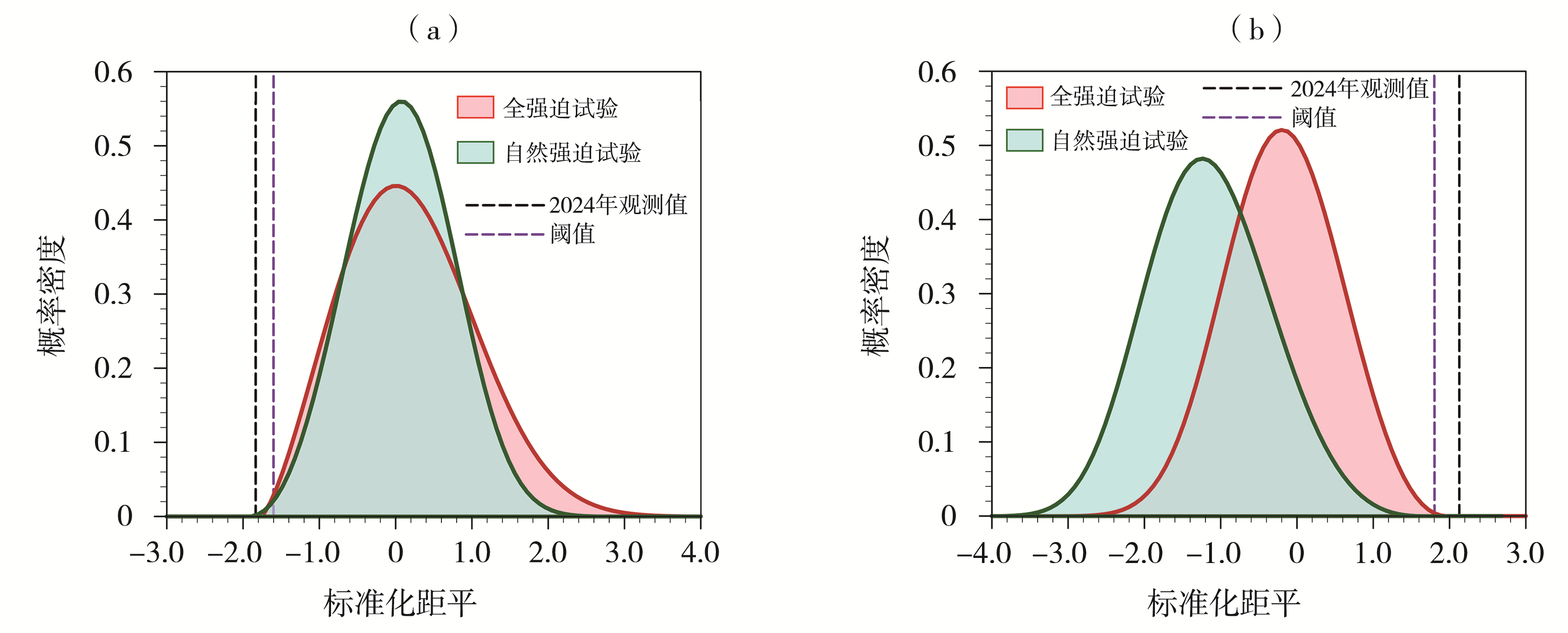干旱气象 ›› 2025, Vol. 43 ›› Issue (5): 667-677.DOI: 10.11755/j.issn.1006-7639-2025-05-0667
2025年1月美国洛杉矶破纪录山火事件的干旱气象条件归因
- 1.新疆大学地理与遥感科学学院,新疆 乌鲁木齐 830017
2.中国科学院大气物理研究所地球系统数值模拟与应用全国重点实验室,北京 100029
3.乌鲁木齐气象卫星地面站,新疆 乌鲁木齐 830011
-
收稿日期:2025-08-20修回日期:2025-09-18出版日期:2025-10-31发布日期:2025-11-09 -
通讯作者:张丽霞(1982—),女,河北保定人,博士,研究员,主要从事极端旱涝事件发生机理及预测研究。E-mail: lixiazhang@mail.iap.ac.cn。
-
作者简介:于晓晶(1987—),女,山东烟台人,博士,副教授,主要从事干旱区气候变化与极端事件归因研究。E-mail: yuxj@xju.edu.cn。 -
基金资助:国家自然科学基金项目(U2342228);国家自然科学基金项目(42305184);中国博士后科学基金项目(2024M752693);地球系统数值模拟装置课题(2025-EL-PT-001070);新疆维吾尔自治区“天池英才”项目
Attribution of drought-related meteorological conditions for the record-breaking wildfire event in Los Angeles in January 2025
YU Xiaojing1( ), ZHANG Lixia2(
), ZHANG Lixia2( ), YU Zhixiang3, YANG Ke’er1
), YU Zhixiang3, YANG Ke’er1
- 1. College of Geography and Remote Sensing Sciences, Xinjiang University, Urumqi 830017, China
2. State Key Laboratory of Earth System Numerical Modeling and Application, Institute of Atmospheric Physics, Chinese Academy of Sciences, Beijing 100029, China
3. Urumqi Meteorological Satellite Ground Station, Urumqi 830011, China
-
Received:2025-08-20Revised:2025-09-18Online:2025-10-31Published:2025-11-09
摘要:
气候增暖背景下,全球山火频率和强度呈显著上升趋势,人为活动可通过改变气候背景条件而显著加剧山火发生风险。2025年1月洛杉矶遭遇破纪录山火事件(简称“25·1”洛杉矶山火事件),前期干燥少雨的干旱状况为其发生提供了有利的气象条件,但气候自然变率和人为外强迫对此类高影响极端干旱事件的定量贡献尚未充分明晰。鉴于此,本文以“25·1”洛杉矶山火事件的关键干旱气象成因为切入点,借助中国科学院大气物理研究所极端事件检测归因系统(Detection and Attribution System of Institute of Atmospheric Physics, Chinese Academy of Sciences,CAS-DASys)开展大样本数值模拟试验并加以归因分析。观测结果表明,在“25·1”洛杉矶山火事件发生前的2024年下半年,美国西部处于持续性降水匮乏和空气干燥状况,其降水量比气候平均态(1981—2010年)偏低约60%、水汽压差(Vapor Pressure Deficit,VPD)偏高0.33 kPa;二者标准化距平分别高达为-1.83和2.13,近44 a(1981—2024年)位列第二。基于CAS-DASys模拟结果的归因分析发现,人为外强迫对美国西部降水变化影响较小,但使得VPD大幅度增加,进而导致类似2024年下半年极端干旱事件的发生。对于类似2024年的极端大气干燥状况,在自然强迫下几乎不可能发生,但在全强迫下发生概率增至0.012%(不确定性范围:0.000 46%~0.110 00%),进而极大增加了类似2024年干燥少雨状况的极端干旱事件发生概率。本研究揭示了全球增暖背景下人为外强迫对区域山火关键干旱气象因子的定量影响,可为山火气象条件的预报预测及其风险应对决策提供科学依据。
中图分类号:
引用本文
于晓晶, 张丽霞, 于志翔, 杨可儿. 2025年1月美国洛杉矶破纪录山火事件的干旱气象条件归因[J]. 干旱气象, 2025, 43(5): 667-677.
YU Xiaojing, ZHANG Lixia, YU Zhixiang, YANG Ke’er. Attribution of drought-related meteorological conditions for the record-breaking wildfire event in Los Angeles in January 2025[J]. Journal of Arid Meteorology, 2025, 43(5): 667-677.

图1 美国西部地区地形(a,单位:m)、国际地圈生物圈计划(International Geosphere Biosphere Programme,IGBP)下垫面覆盖类型(b)空间分布 (三角符号表示洛杉矶位置,下同;b图中数字表示IGBP植被覆盖类型依次为:0 水,1 常绿针叶林,2 常绿阔叶林,3 落叶针叶林,4 落叶阔叶林,5 混交林,6 郁闭灌丛,7 开放灌丛,8 多树草原,9 稀树草原,10 草原,11 永久湿地,12 作物,13 城市和建成区,14 作物和自然植被的镶嵌体,15 雪、冰,16 裸地或低植被覆盖地,17 未分类区)
Fig.1 Spatial distribution of the topography of the western America (a, Unit: m) and IGBP land cover type (b) (The triangles denote the location of Los Angeles, the same as below ; The numbers for IGBP vegetation types in fig. b are as follows: 0 denotes water, 1 evergreen needleleaf forest, 2 evergreen broadleaf forest, 3 deciduous needleleaf forest, 4 deciduous broadleaf forest, 5 mixed forest, 6 closed shrubland, 7 open shrublands, 8 woody savannas, 9 savannas, 10 grasslands, 11 permanent wetlands, 12 croplands, 13 urban and built_up, 14 cropland natural vegetation mosaic, 15 snow and ice, 16 barren or sparsely vegetated, and 17 unclassified)

图2 1981—2020年7—12月美国西部地区降水量(a,单位:mm)、水汽压差(b,单位:kPa)、植被总初级生产力(c,单位:gC·m-2)和火情天气指数(d)的气候态空间分布
Fig.2 The climatological spatial distribution of precipitation (a, Unit: mm), VPD (b, Unit: kPa), GPP (c, Unit: gC·m-2) and FWI (d) in the western United States from July to December during 1981-2020

图3 2025年1月美国洛杉矶山火过程中火点数量及过火面积逐日变化(a)、火点等级分布(b)、洛杉矶及其周边地区FWI的逐日变化(c)及7—9日平均FWI的空间分布(d)
Fig.3 The daily variation of fire spot numbers and burned area (a), the distribution of fire spot grade (b), the daily variation of FWI in Los Angeles and its surrounding areas (c) and the spatial distribution of average FWI from 7 to 9 (d) during the January 2025 Los Angeles wildfires in USA

图4 2024年(a、b、c)及2024年7—12月(d、e、f)美国西部地区降水距平百分率(a、d)(单位:%)、VPD距平(b、e)(单位:kPa)和FWI距平(c、f)的逐月变化(a、b、c)及空间分布(d、e、f) [图4(d)、(e)、(f)中蓝色方框区域(25°N—38°N,120°W—110°W)分别为图4(a)、(b)、(c)的取值区域,数字表示蓝色方框区域平均值]
Fig.4 The monthly variations (a, b, c) and spatial distributions (d, e, f) of precipitation anomaly percentage (a, d) (Unit: %), VPD anomaly (b, e) (Unit: kPa) and FWI anomaly (c, f) in the western United States in 2024 (a, b, c) and from July to December 2024 (d, e, f) (The blue boxed area (25°N-38°N, 120°W-110°W) in Figure 4 (d), (e), and (f) serves as the value-extraction region for Figure 4 (a), (b), and (c), respectively, and the number denotes the average value of the blue boxed area)

图5 1981—2024年7—12月美国西部(25°N—38°N,120°W—110°W;下同)降水、VPD和FWI标准化距平的时间序列(a)和散点图(b)
Fig.5 Time series (a) and scatter plot (b) of standardized anomalies of precipitation, VPD and FWI area-averaged over the western United States (25°N-38°N, 120°W-110°W; the same as below) from July to December during 1981-2024

图6 1980—2020年7—12月美国西部区域平均的降水(a)和VPD(b)观测值和CAS-DASys模拟结果的标准化距平 (阴影表示多成员模拟结果的离散度)
Fig.6 Standardized anomalies of observed and CAS-DASys simulated regional average precipitation (a) and VPD (b) in the western United States from July to December during 1980-2020 (The shading represents the spread among multi-members simulation results)

图7 CAS-DAsys大样本模拟的2024年7—12月美国西部降水和VPD标准化距平的散点图
Fig.7 The scatter plot of standardized anomalies of precipitation and VPD in the western United States from July to December 2024 based on the CAS-DAsys large ensemble simulations

图8 基于CAS-DAsys全强迫和自然强迫试验结果拟合的美国西部2024年7—12月降水(a)和VPD(b)标准化距平的概率密度分布
Fig.8 The probability density distribution of standardized anomalies of precipitation (a) and VPD (b) in the western United States from July to December 2024 based on the CAS-DAsys all-forcing and natural-forcing experiment simulations

图9 基于CAS-DAsys全强迫(a)和自然强迫(b)试验结果拟合的美国西部2024年7—12月降水和VPD标准化距平的联合概率密度分布
Fig.9 The joint probability density distribution of standardized anomalies of precipitation (a) and VPD (b) in the western United States from July to December 2024 based on the CAS-DAsys all-forcing (a) and natural-forcing (b) experiment simulations
| [1] | 牛若芸, 翟盘茂, 佘万明, 2007. 森林火险气象指数的应用研究[J]. 应用气象学报, 18(4):479-489. |
| [2] | 牛若芸, 翟盘茂, 孙明华, 2006. 森林火险气象指数及其构建方法回顾[J]. 气象, 32(12):3-9. |
| [3] | 田永丽, 王秋华, 2019. 气象条件异常对美国加利福尼亚州山火的影响[J]. 森林防火(3):21-25. |
| [4] | 严中伟, 华丽娟, 钱诚, 等, 2024. 气候统计方法和应用[M]. 北京: 北京科学出版社:16-17. |
| [5] | 郑伟, 陈洁, 闫华, 等, 2020. FY-3D/MERSI-II全球火点监测产品及其应用[J]. 遥感学报, 24(5):521-530. |
| [6] | ABATZOGLOU J T, KOLDEN C A, CULLEN A C, et al, 2025. Climate change has increased the odds of extreme regional forest fire years globally[J]. Nature Communications, 16: 6390. DOI:10.1038/s41467-025-61608-1. |
| [7] | ABATZOGLOU J T, WILLIAMS A P, 2016. Impact of anthropogenic climate change on wildfire across western US forests[J]. Proceedings of the National Academy of Sciences of the United States of America, 113(42): 11 770-11 775. |
| [8] | ALLEN R G, PEREIRA L S, RAES D, et al, 1998. Crop evapotranspiration-Guidelines for computing crop water requirements-FAO Irrigation and drainage paper 56[M]. Rome: FAO: 300. |
| [9] | AYARS J, KRAMER H A, JONES G M, 2023. The 2020 to 2021 California megafires and their impacts on wildlife habitat[J]. Proceedings of the National Academy of Sciences of the United States of America, 120(48): e2312909120. DOI:10.1073/pnas.2312909120. |
| [10] | BOWMAN D M J S, KOLDEN C A, ABATZOGLOU J T, et al, 2020. Vegetation fires in the anthropocene[J]. Nature Reviews Earth & Environment, 1(10): 500-515. |
| [11] | BOWMAN D M J S, WILLIAMSON G J, ABATZOGLOU J T, et al, 2017. Human exposure and sensitivity to globally extreme wildfire events[J]. Nature Ecology & Evolution, 1: 58. DOI:10.1038/s41559-016-0058. |
| [12] |
BROWN P T, HANLEY H, MAHESH A, et al, 2023. Climate warming increases extreme daily wildfire growth risk in California[J]. Nature, 621(7980):760-766.
DOI |
| [13] | CHEN X D, LEUNG L R, DONG L, 2023. Antecedent hydrometeorological conditions of wildfire occurrence in the western U.S. in a changing climate[J]. Journal of Geophysical Research: Atmospheres, 128: e2023JD039136. DOI:10.1029/2023JD039136. |
| [14] | CUNNINGHAM C X, WILLIAMSON G J, BOWMAN D M J S, 2024. Increasing frequency and intensity of the most extreme wildfires on Earth[J]. Nature Ecology & Evolution, 8(8): 1 420-1 425. |
| [15] | DONG C Y, WILLIAMS A P, ABATZOGLOU J T, et al, 2022. The season for large fires in Southern California is projected to lengthen in a changing climate[J]. Communications Earth & Environment, 3:22. DOI:10.1038/s43247-022-00344-6. |
| [16] | DONG L, LEUNG L R, QIAN Y, et al, 2021. Meteorological environments associated with California wildfires and their potential roles in wildfire changes during 1984-2017[J]. Journal of Geophysical Research: Atmospheres, 126(5): e2020JD033180. DOI:10.1029/2020JD033180. |
| [17] | EFRON B, TIBSHIRANI R J, 1994. An introduction to the bootstrap[M]. New York: Chapman and Hall. |
| [18] |
EYRING V, BONY S, MEEHL G A, et al, 2016. Overview of the Coupled Model Intercomparison Project Phase 6 (CMIP6) experimental design and organization[J]. Geoscientific Model Development, 9(5): 1 937-1 958.
DOI URL |
| [19] | GINCHEVA A, PAUSAS J G, TORRES-VÁZQUEZ M Á, et al, 2024. The interannual variability of global burned area is mostly explained by climatic drivers[J]. Earth's Future, 12(7). DOI: 10.1029/2023EF004334. |
| [20] |
HERSBACH H, BELL B, BERRISFORD P, et al, 2020. The ERA5 global reanalysis[J]. Quarterly Journal of the Royal Meteorological Society, 146(730): 1 999-2 049.
DOI URL |
| [21] |
JAIN P, CASTELLANOS-ACUNA D, COOGAN S C P, et al, 2022. Observed increases in extreme fire weather driven by atmospheric humidity and temperature[J]. Nature Climate Change, 12(1): 63-70.
DOI |
| [22] |
JUNG M, KOIRALA S, WEBER U, et al, 2019. The FLUXCOM ensemble of global land-atmosphere energy fluxes[J]. Scientific Data, 6: 74. DOI:10.1038/s41597-019-0076-8.
PMID |
| [23] | LI L J, DONG L, XIE J B, et al, 2020. The GAMIL3: Model description and evaluation[J]. Journal of Geophysical Research: Atmospheres, 125(15): e2020JD032574. DOI:10.1029/2020JD032574. |
| [24] | LUKE R H, MCARTHUR A G, 1978. Bush Fires in Australia[R]. Canberra: Australian Government Publishing Service. |
| [25] | MADAKUMBURA G D, MORITZ M A, MCKINNON K A, et al, 2025. Anthropogenic warming drives earlier wildfire season onset in California[J]. Science Advances, 11(32): eadt2041. DOI:10.1126/sciadv.adt2041. |
| [26] |
MASS C F, OVENS D, 2019. The northern California wildfires of 8-9 October 2017: The role of a major downslope wind event[J]. Bulletin of the American Meteorological Society, 100(2): 235-256.
DOI URL |
| [27] | OSTOJA S M, CRIMMINS A R, BYRON R G, et al, 2023. Focus on western wildfires The Fifth National Climate Assessment[M]. Washington, District of Columbia: United States Government Publishing Office. |
| [28] | QIU M H, CHEN D Y, KELP M, et al, 2025. The rising threats of wildland-urban interface fires in the era of climate change: The Los Angeles 2025 fires[J]. Innovation, 6(5): 100835. DOI:10.1016/j.xinn.2025.100835. |
| [29] |
RADELOFF V C, MOCKRIN M H, HELMERS D, et al, 2023. Rising wildfire risk to houses in the United States, especially in grasslands and shrublands[J]. Science, 382(6671):702-707.
DOI PMID |
| [30] | RICHARDSON D, BLACK A S, IRVING D, et al, 2022. Global increase in wildfire potential from compound fire weather and drought[J]. NPJ Climate and Atmospheric Science, 5: 23. DOI:10.1038/s41612-022-00248-4. |
| [31] | STONE D A, CHRISTIDIS N, FOLLAND C, et al, 2019. Experiment design of the international CLIVAR C20C+ detection and attribution project[J]. Weather and Climate Extremes, 24:100206. DOI:10.1016/j.wace.2019.100206. |
| [32] | SWAIN D L, 2021. A shorter, sharper rainy season amplifies California wildfire risk[J]. Geophysical Research Letters, 48(5): e2021GL092843. DOI:10.1029/2021GL092843. |
| [33] | UNITED NATIONS ENVIRONMENT PROGRAM, 2022. Spreading like Wildfire: The Rising Threat of Extraordinary Landscape Fires. A UNEP Rapid Response Assessment[R]. Nairobi: UNEP. |
| [34] | VAN WAGNER C E, 1987. Development and structure of the Canadian Forest Fire Weather Index System[R]. Ottawa: Canadian Forestry Service. |
| [35] |
VITOLO C, DI GIUSEPPE F, BARNARD C, et al, 2020. ERA5-based global meteorological wildfire danger maps[J]. Scientific Data, 7(1): 216. DOI:10.1038/s41597-020-0554-z.
PMID |
| [36] |
WILLIAMS A P, ABATZOGLOU J T, GERSHUNOV A, et al, 2019. Observed impacts of anthropogenic climate change on wildfire in California[J]. Earth’s Future, 7(8):892-910.
DOI URL |
| [37] |
ZHANG L X, YU X J, ZHOU T J, et al, 2023. Understanding and attribution of extreme heat and drought events in 2022: Current situation and future challenges[J]. Advances in Atmospheric Sciences, 40(11):1 941-1 951.
DOI |
| [38] |
ZHANG L X, ZHOU T J, ZHANG X, et al, 2024. Attribution of the extreme 2022 summer drought along the Yangtze River valley in China based on detection and attribution system of Chinese academy of sciences[J]. Bulletin of the American Meteorological Society, 105(7): E1062-E1067.
DOI URL |
| [39] | ZHUANG Y Z, FU R, SANTER B D, et al, 2021. Quantifying contributions of natural variability and anthropogenic forcings on increased fire weather risk over the western United States[J]. Proceedings of the National Academy of Sciences of the United States of America, 118(45): e2111875118. DOI:10.1073/pnas.2111875118. |
| [1] | 任余龙,李耀辉,段海霞,宋琳琳. 我国西北东部春季一次极端干旱事件的数值模拟及波—流作用分析[J]. 干旱气象, 2017, 35(4): 535-544. |
| [2] | 董安祥,李耀辉,柳媛普. 1941 ~ 1943 年中国北方大旱的特点及其影响[J]. J4, 2011, 29(4): 423-426. |
| [3] | 董安祥, 柳媛普, 李晓苹, 白虎志. 黄河流域1922 ~ 1932 年特大旱灾的特点及其影响[J]. J4, 2010, 28(3): 270-278. |
| 阅读次数 | ||||||
|
全文 |
|
|||||
|
摘要 |
|
|||||
